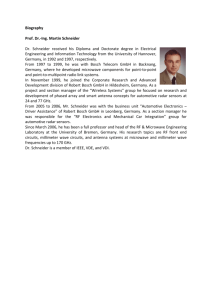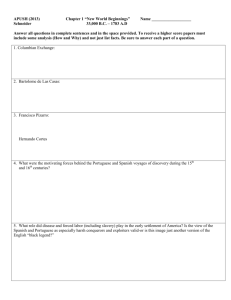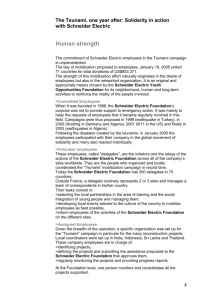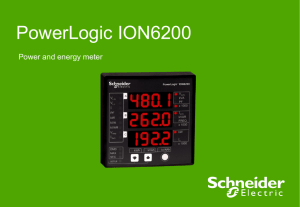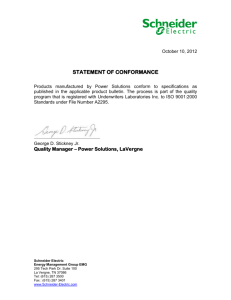Schneider Electric Case Study Square D Manufacturing Facilities
advertisement
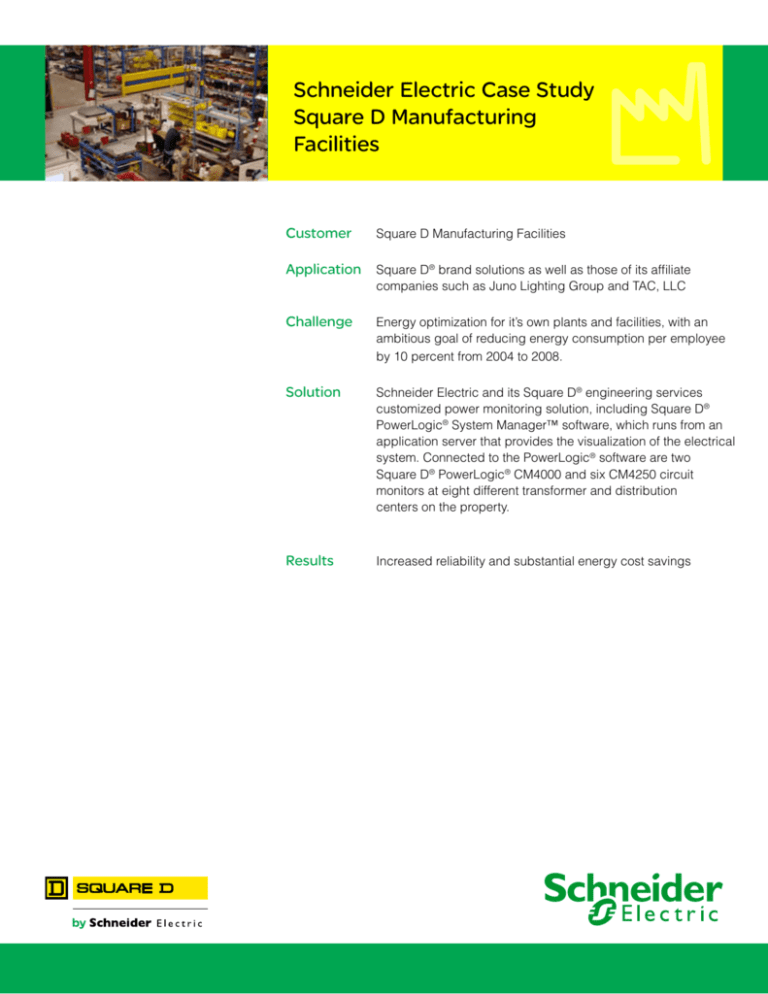
Schneider Electric Case Study Square D Manufacturing Facilities Customer Square D Manufacturing Facilities Application Square D® brand solutions as well as those of its affiliate companies such as Juno Lighting Group and TAC, LLC Challenge Energy optimization for it’s own plants and facilities, with an ambitious goal of reducing energy consumption per employee by 10 percent from 2004 to 2008. Solution Schneider Electric and its Square D® engineering services customized power monitoring solution, including Square D® PowerLogic® System Manager™ software, which runs from an application server that provides the visualization of the electrical system. Connected to the PowerLogic® software are two Square D® PowerLogic® CM4000 and six CM4250 circuit monitors at eight different transformer and distribution centers on the property. Results Increased reliability and substantial energy cost savings Schneider Electric Case Study Square D Manufacturing Facilities SCHNEIDER ELECTRIC LAUNCHES MAJOR NORTH AMERICAN ENERGY SAVINGS INITIATIVE USING ITS OWN SOLUTIONS $3.7 Million in Energy Savings Realized in First Three Years As a global leader in electrical distribution, monitoring and control equipment, Schneider Electric has helped thousands of customers around the world save money and protect the environment through reduced energy consumption. In 2004, the company began an energy optimization project for what was to be its most important customer yet – itself. Focused primarily on its North American Operating Division, Schneider Electric used its own solutions within 21 of its facilities spread across the United States, Mexico and Canada. The program set out with an ambitious goal of reducing energy consumption per employee by 10 percent from 2004 to 2008. By applying many of its own Square D® brand solutions as well as those of its affiliate companies such as Juno Lighting Group and TAC, LLC, Schneider Electric successfully created one of the more energy efficient manufacturing operations anywhere. Energy savings from 2005 through 2007 totaled more than $3.7 million. Perhaps most noteworthy, the company’s goal of reducing energy consumption per employee by 10 percent by 2008 was met a full two years ahead of schedule. Front-end Analysis As the first step in the energy optimization project, Schneider Electric turned to its comprehensive energy analysis and management services known as Square D® Total Energy Control™. The energy experts examined the energy usage patterns and demands of all major North American facilities. After identifying all possible opportunities to improve energy efficiency, they prioritized the opportunities based on the initial cost and expected payback period. Projects with the greatest potential savings and quickest payback were among the first to be undertaken. Those projects could be categorized into five areas – heating, compressed air systems, lighting, air conditioning and specific manufacturing processes. Once projects were initiated at each of the sites, facility managers would report new energy usage patterns and the resulting savings on a monthly basis. During a quarterly conference call, energy teams at each of the facilities share information on new and existing projects. Additionally, they meet in person once a year to discuss best practices that have been established and how they can be replicated companywide. Better Management Begins with Better Monitoring Numerous equipment upgrades were undertaken that contributed to the overall energy savings. Among the first were the installation of several Square D PowerLogic® circuit monitors allowing for up-to-the-minute energy usage and quality readings as well as long-term trending. The PowerLogic® monitoring systems allow managers to set energy usage benchmarks within each facility, make system or process adjustments and track possible savings against the original levels. P2 Schneider Electric Case Study Square D Manufacturing Facilities More than 180 separate devices in 24 facilities are currently using the circuit monitors. This metering is proving critical in identifying demand savings opportunities. In addition, it gives managers the data necessary to verify utility bills and ensure that all energy expenses are accurate. Make Energy a Variable, Manageable Cost with Enterprise Energy Management Software Integrated with its power monitoring system, Schneider installed its own PowerLogic® ION® EEM enterprise energy management software to further manage its operations in three areas: energy conservation, operational optimization and environmental sustainability. The PowerLogic ION EEM system integrates electricity, air, gas, steam and water to quantify the cost of energy and its relationship with an enterprise’s everyday business processes. The PowerLogic ION EEM solution is geared around saving money through improving equipment/process/facility efficiency, maximizing equipment and process reliability and minimizing energy intensity and reducing usage. It’s a unifying software application that complements and extends the benefits of existing energy-related data resources with features like key performance indicators and advanced analytics. Data is automatically acquired, cleansed and warehoused. Personalized, browser-based dashboards and innovative visualization and modeling tools help accurately monitor, predict and ultimately control all energyrelated expenses and risks to reliability. EEM’s key performance indicators and advanced analytics help Schneider Electric manage energy in financial terms and gain unique insight into the impacts of power quality on its business and all energy assets. Schneider Electric is also able to benchmark and compare facility performance across all its operations to identify energy inefficiencies or losses, and it can measure and verify savings from energy conservation projects or performance contracts. In addition, the software reveals what sites are ahead or behind in their energy goals. Finally, EEM is also beneficial in meeting corporate environmental stewardship goals and mandated impact targets. The software even has the ability to monitor greenhouse gas emissions – by collecting pertinent data and converting energy reductions to greenhouse gas emissions. Using the EEM software, Schneider Electric was able to quantify that its reduced electrical demand as a result of its energy efficiency efforts resulted in 30,000 less tons of CO2 being produced by electric utilities, amounting to a nine percent reduction in greenhouse gases. Lighting the Way to Energy Efficiency High efficiency lighting fixtures and lighting control also represent significant savings in the project. By leveraging the Juno Lighting Group products and its mix of high efficiency fixtures, Schneider Electric’s facilities saw an annual savings of more than 8,000,000 kilowatt hours, resulting in more than $580,000 in annual electricity savings. The installation also amounted to $196,000 in tax benefits. The lighting replacement project had the added benefit of swapping out yellow lights with more illuminating white lights, a change that was well received by staff. P3 Schneider Electric Case Study Square D Manufacturing Facilities P4 Approximately 7,000 Juno lighting fixtures were installed, which on its own reduced the Schneider Electric North American electricity bill by more than four percent. Multiple lighting controls were also installed within the Schneider Electric facilities, including Square D® occupancy and light-level sensors, Clipsal® lighting controls, and PowerLink® branch circuit lighting controls. By integrating this mix of lighting control tools through the PowerLink® software, lights are automatically turned on and off using either a predetermined schedule or manual overrides. In either case, the PowerLink® system ensures that lights are turned on only when needed and off when they are not. Improving HVAC Output through Better Technology Schneider Electric also set out to reduce the power consumption of the motors used in its HVAC system and manufacturing process by installing Altivar® variable frequency drives (VFDs). Since January 2004, over 50 VFDs were installed at 10 Schneider Electric sites. The new drives provide improved control over motor operations and the ability to run at only a percentage of the motor speed, resulting in less power being used in the application. In addition to improving the HVAC system through VFDs, Schneider Electric sought to fully automate several of its buildings through its TAC solution offering. TAC is a Schneider Electric-owned brand specializing in the design and implementation of automated building systems while also providing energy management services. Using the TAC building automation software, i/net, facilities reduced their energy consumption through better building controls. The new building automation systems allow each of the facility managers to integrate, control and monitor the HVAC, security, lighting, fire and other building systems through one comprehensive application. With better control came greater overall efficiency. The Payback The resulting savings from the efforts were nothing short of amazing for facility managers and their energy teams. Electricity consumption within the target facilities dropped 9 percent from 2004 to 2007, despite significant production increases during that same period, with sales increasing more than 40 percent during the three-year window. Since 2004, electrical savings amounted to more than 35 million kilowatt hours – a savings of more than $2.55 million. Natural gas consumption also decreased 9 percent from 2004 through 2007. This considerable savings was realized despite the increase in sales, abnormally cold winters and a new painting process introduced at several facilities in 2007, which requires a higher amount of natural gas. The three-year savings totaled more than 106,000 dekatherms – a savings of more than $1.2 million. Schneider Electric Case Study Square D Manufacturing Facilities P5 Savings through Modified Behavior The first energy-saving steps recommended by Schneider Electric’s in-house experts were also some of the simplest. Often requiring little or no investment, a focus was placed on possible behavioral changes that could reduce consumption at each facility. For example, project leaders took steps to optimize the heating or cooling temperature within the manufacturing plants. Facility managers regulated temperatures so that they were no warmer than 68 degrees in the winter and no cooler than 75 degrees in the summer. Given the size and number of all work areas, keeping room temperatures within the appropriate range was an important part of optimizing the overall efficiency. In fact, fuel consumption increases by 1.5 - two percent for every degree of over-heating. Other simple behavioral changes that were undertaken included actively shutting down production equipment when not in use, activating computer and monitor energy-saving software, reminding staff to shut outside doors or turn off lights when rooms are not in use. Controlling peak demands was another step that came as a result of the energy usage analysis provided by the Total Energy Control program. By examining each facility’s overall consumption and adjusting processes to shed loads and avoid usage peaks, the facilities were able to procure better rates by the utility and, in the end, complete the same amount of work at a lower cost. The experts were also helpful in reviewing utility contracts and ensuring that each facility’s current demand profile matched their existing contract. Where contracts did not accurately reflect usage patterns, contract renegotiations were initiated, resulting in more favorable rates. Staying creative can also help. In Schneider Electric’s Peru, Ind. plant, managers have instituted the “Bright Idea Program,” in which the submitter of the best energy efficiency idea each month wins a prize. Plans are currently underway to expand the energy optimization project to include 21 additional Schneider Electric-owned facilities in the next few years. And, energy-saving projects will continue at the original sites. Schneider Electric will continue to make energy efficiency a priority in its own operations. Schneider Electric - North American Operating Division 295 Tech Park Drive LaVergne, TN 37086 Tel: 866-466-7627 Toll Free PowerLogic.com Square D, PowerLogic, System Manager and Modbus are trademarks or registered trademarks of Schneider Electric and/or its affiliates in the United States and/or other countries. Other marks used herein are the property of their respective owners.


